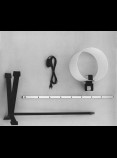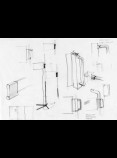Function, ingenuity and technology


‘The concept is to find the right technology, neither too much nor too little, but just what is needed every time’
The ‘Milá lamp’ is not only a master class in functionalism but also a lesson in balance and nuances in the illumination and mere occupation of household space. None of this comes by chance: from the early TN to the subsequent Previa, until reaching the ideal measure with the TMC and the TMM, the lamps’ efficacy was gradually calibrated through successive adjustments until they reached their final shape. Milá says: ‘The former is wearing a tux; the TMM has jeans on’. In addition to the materials, the most striking part of that garment change may be the mechanism used to move the lamp: in the TMC, it is a handle integrated into the shaft which can be set at different heights using holes where it can be locked in; in the TMM, this function is performed by a sliding rubber joint. Thus, the TMM is an example of versatility and multiple uses with DIY technology. The Cesta is another paradigmatic example: after the first model was adjusted for industrial reproduction —by replacing the rattan with wood— it has evolved through different versions and taken on different nuances without ever losing the light look that makes it one of the most delicate and harmonious lamps around.
Therefore, it encapsulates the 'evolutionary’ nature that Miguel Milá confers on his pieces, beyond any desire to be cutting-edge. Quim Larrea and Juli Capella, designers and design theoreticians, say: ‘Miguel doesn’t turn his back on technology but instead seeks the right technology for each need. Behind its simple appearance, the TMC conceals a vast number of ingenious resources that make it a masterpiece.’
Actually both ingenuity and common-sense observation come into play here, the preliminary factors in making Milá's designs ‘presentable’, even beautiful. His designs lack complications, affectations and garishness. Therefore, the functional premise becomes an aesthetic requirement that is often revealed after the fact, as if beauty was the least common denominator in the quest for the essential. In this quest, Technology seems to be camouflaged in an eerily natural way: ‘For me, updating means seeking simpler unions’.
In 1961, when ADI-FAD (Industrial Design Association) had just been founded, Miguel Milá joined it along with such prominent designers as Antoni Moragas, André Ricard, Manuel Cases, Maria Rosa Ventós, Joaquim Belsa, Jordi Galí and Rafael Marquina. After that, the first design awards and exhibitions began in Spain, as well as participation in international conferences like the ICSID (International Council of Societies of Industrial Design), where they met influential designers like Gio Ponti, Achille Castiglioni, Gillo Dorfles, Alvar Aalto, Ilmari Tapiovaara and Vico Magistretti. Miguel defined this period as ‘an organic process of collective interest. We spoke, shared ideas, became interested in what was being done elsewhere. It was a time of vibrancy when everything was yet To be done —building a world that reflected our generation.’ That same year, Miguel began to teach at Elisava design school, where he remained until 1970; he also started teaching classes at Eina design school in 1967. Milá had been associated with Eina since it was founded: he was a lecturer and design teacher in Furniture and Projects and an instructor in the post-graduate programme on Interiors until early 2000, among other collaborations. In 1987, Miguel Milá was named a Friend of Eina because of his involvement with the school from the very start.

